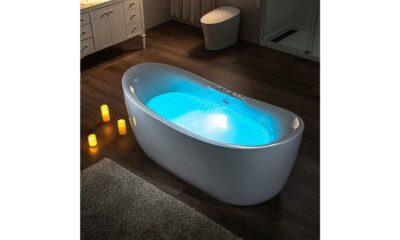Home Decor
Timeless Navy Blue Shiplap Walls: Why Choose This Classic Design?
Achieve a sophisticated ambiance in any room with navy blue shiplap walls, a timeless design that elevates style and adds dramatic flair.
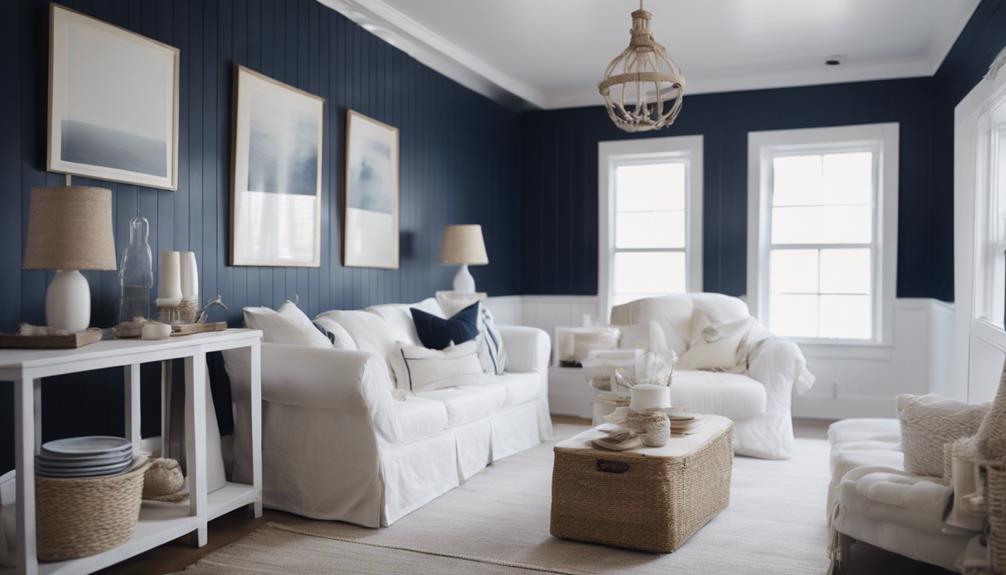
You're drawn to the timeless allure of navy blue shiplap walls because they evoke the luxurious ambiance of high-end hotels, upscale restaurants, and fashion brands, offering a versatile and sophisticated way to elevate the aesthetic of any room. This classic design choice provides a striking accent wall, enhances productivity in home offices, and adds personality to small kitchen spaces. Navy blue shiplap walls maintain their popularity due to their versatility and dramatic flair, making them a stylish choice for any space. As you explore this timeless design, you'll discover the countless ways it can transform your home's ambiance and character.
Key Takeaways
• Navy blue shiplap walls offer a timeless appeal that endures through changing trends and design styles.
• The versatile navy blue color adds depth and sophistication to any space, making it a classic design choice.
• Navy blue shiplap walls create a striking accent wall that enhances productivity and professionalism in home offices and adds personality to small kitchen spaces.
• Pairing navy blue shiplap with metallic accents, neutral tones, or bold patterns creates a visually striking contrast and adds elegance to any room.
• The dramatic, rich hue of navy blue shiplap commands attention, instantly elevating a room's ambiance and making a bold statement with its striking color choice.
Navy Blue Shiplap Design Inspiration
When designing a sophisticated space, you can draw navy blue shiplap design inspiration from luxurious hotels, upscale restaurants, or even high-end fashion brands that often pair navy blue with metallic accents for a sleek, modern look. By incorporating navy blue shiplap accent walls, you can create an elegant ambiance in any room, perfect for making a statement.
Imagine walking into a room with a stunning navy blue accent wall that demands attention and sets the tone for a sophisticated atmosphere. This design inspiration can be applied to various spaces, including home offices, where it can enhance productivity and professionalism. Additionally, a navy blue accent wall can add visual interest to a small kitchen, defining the design and creating a sense of luxury.
Whether you're looking to create a modern, luxurious, or elegant space, navy blue shiplap accent walls are an excellent design choice.
Accent Wall Ideas to Try Now
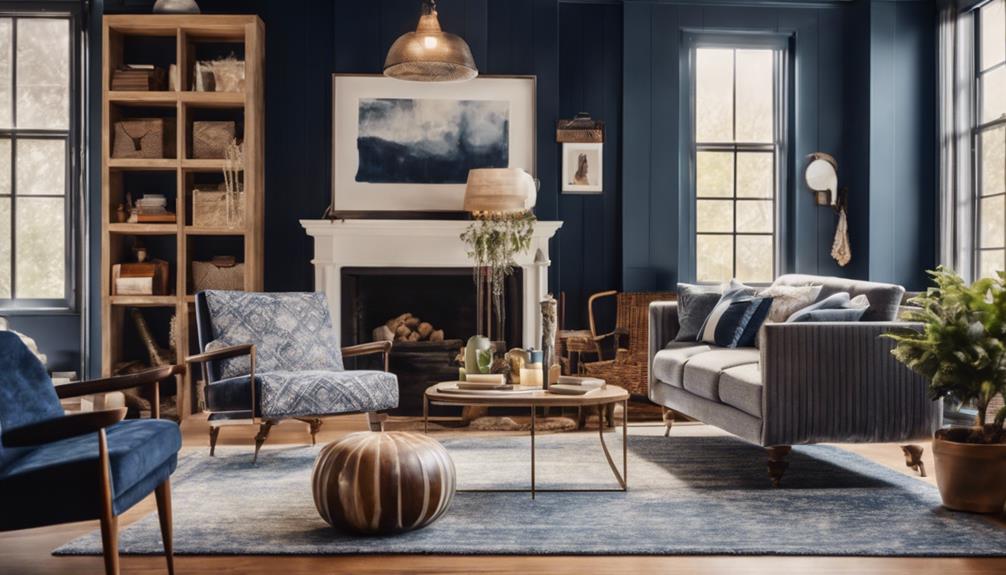
As you explore accent wall ideas to try now, you'll discover a range of styles that can elevate your navy blue shiplap walls.
From embracing coastal chic vibes only to experimenting with bold pattern play, you can create a unique look that reflects your personality.
Coastal Chic Vibes Only
To evoke the essence of a seaside retreat, incorporate navy blue shiplap accent walls into your design, and get ready to transport your space to a tranquil coastal oasis. The deep, calming blue tones of navy shiplap bring a sense of tranquility and elegance to any space, especially in coastal-themed designs. By incorporating navy blue shiplap accent walls, you'll create a sophisticated and calming atmosphere that's perfect for relaxing and unwinding.
Here are some ways to make the most of navy blue shiplap accent walls:
- Pair with natural elements: Combine navy blue shiplap with natural elements like driftwood-inspired decor to create a cohesive coastal look.
- Use as a focal point: Consider using navy blue shiplap on a focal wall to showcase artwork or create a stylish backdrop for furniture.
- Add a pop of contrast: Paint navy blue shiplap in a rich, bold hue like Hale Navy HC-154 to create a dramatic statement in your space.
Bold Pattern Play
Try pairing navy blue shiplap accent walls with bold pattern play to create a visually striking contrast that adds texture and visual interest to your space.
By incorporating bold patterns, such as geometric shapes, florals, or stripes, you can create a dynamic and eclectic look that's sure to turn heads. The key is to balance the boldness of the pattern with the richness of the navy blue shiplap walls, which add a touch of elegance and luxury to your home decor.
To achieve this balance, consider pairing bold patterns with neutral elements, such as white or beige furniture, to prevent visual overload. Alternatively, you can use the navy blue shiplap walls as a backdrop for a bold, patterned rug or statement furniture piece. The result is a visually striking space that's full of contrast and visual interest.
With navy blue shiplap walls as your foundation, the possibilities for bold pattern play are endless, and the outcome is sure to be a space that's both stylish and sophisticated.
Soft Neutral Pairings
Now that you've chosen navy blue shiplap walls, it's time to select a complementary color scheme that won't compete with their richness, and soft neutral pairings are an excellent way to achieve a harmonious balance. Soft neutrals can create a calming atmosphere, and when paired with navy blue shiplap, they bring a sense of serenity to the space.
Here are three soft neutral pairings to explore:
- Creamy Whites: Paint colors like Benjamin Moore's Swiss Coffee or Sherwin-Williams' Snowbound provide a balanced contrast to navy blue shiplap, creating a soothing ambiance.
- Subtle Blues: Farrow & Ball's Green Blue or Sherwin-Williams' Portsmouth can create a calming atmosphere when paired with navy blue shiplap, perfect for a relaxing retreat.
- Classic Whites: Benjamin Moore's White Dove or Sherwin-Williams' Alabaster offer a timeless and elegant pairing with navy blue shiplap, ideal for a sophisticated look.
When selecting a wall paint, remember that soft neutrals can enhance the classic appeal of navy blue shiplap walls. By choosing the right paint colors, you can create a harmonious and calming space that exudes elegance and sophistication.
Benefits of Timeless Design Choices
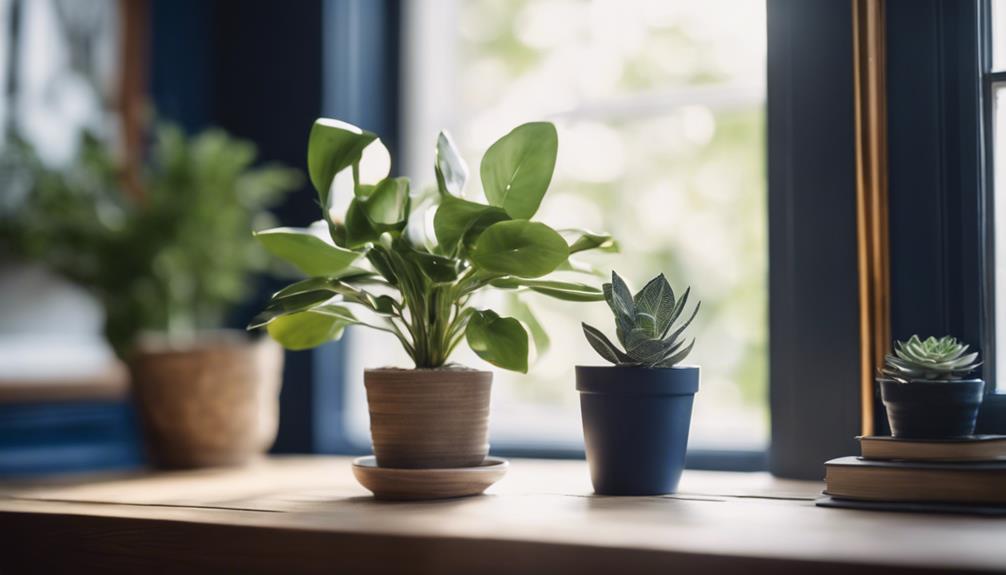
As you consider incorporating navy blue shiplap walls into your design, you'll appreciate the benefits of timeless design choices that exude classic style, which endures through the years.
With a navy blue shiplap wall, you'll create an elegant aesthetic appeal that adds sophistication to your space.
Classic Style Endures
By opting for navy blue shiplap walls, you're making a design choice that will guarantee the test of time, effortlessly outlasting fleeting trends and decor fads. This classic design choice guarantees that your space remains stylish and sophisticated, even as trends come and go. With navy blue shiplap walls, you can create a timeless ambiance that exudes elegance and refinement.
Here are three benefits of choosing navy blue shiplap walls:
- Timeless appeal: Navy blue shiplap walls offer a classic design choice that remains stylish and sophisticated, even as trends change.
- Versatility: The versatile navy blue color adds depth and sophistication to any space, making it perfect for various interior design styles.
- Elevated ambiance: Navy blue shiplap walls create a stylish and elegant ambiance, effortlessly elevating the overall aesthetic of your space.
Elegant Aesthetic Appeal
With navy blue shiplap walls, you'll create a sophisticated space that exudes calmness and tranquility, all while making a bold statement. The deep, rich hue of navy blue adds a level of sophistication to the room's overall design, making it perfect for those who want to create a stylish and calm atmosphere.
Unlike a bland, neutral paint color, navy blue shiplap walls make a statement without overwhelming the senses. This timeless design choice creates a classic and stylish backdrop for various decor styles, from traditional to modern.
Whether you're going for a coastal vibe or a sophisticated urban look, navy blue shiplap walls provide the perfect foundation. The versatility of this design choice allows it to work seamlessly in both traditional and modern settings, making it an excellent choice for anyone looking to add a touch of elegance to their space.
Lasting Visual Impact
You'll find that navy blue shiplap walls continue to captivate the senses long after the initial impression, thanks to their timeless design that makes a lasting visual impact. The classic navy blue color choice creates a striking focal point while maintaining a sense of elegance, adding sophistication and depth to any space. This enduring appeal lies in their ability to create a bold statement while remaining a classic and timeless design choice.
Here are just a few ways navy blue shiplap walls make a lasting visual impact:
- Sophistication and Elegance:
Navy blue shiplap walls add a touch of sophistication and elegance to any room, making it perfect for those who want to create a refined atmosphere.
- Versatility:
Choosing navy blue for shiplap walls provides a versatile backdrop that complements a wide range of decor styles and color schemes.
- Calmness and Serenity:
Navy blue shiplap walls can add a sense of calmness and serenity to a room, enhancing its overall ambiance.
Why Navy Blue Shiplap Stands Out

Navy blue shiplap's dramatic, rich hue commands attention, instantly elevating a room's ambiance and making a bold statement. You'll find that this classic design element stands out in any space, adding depth and sophistication to even the most mundane rooms.
One of the primary reasons navy blue shiplap stands out is its ability to create a striking accent wall, drawing the eye and creating a focal point in the room. This bold, yet timeless, design choice pairs perfectly with gold accents, resulting in a luxurious and elegant aesthetic.
In addition, incorporating navy blue shiplap in a home office can enhance productivity and create a stylish work environment. Even in small kitchen spaces, painting the back of lower cabinets with navy blue shiplap can add personality and visual interest.
With its versatility and dramatic flair, it's no wonder navy blue shiplap remains a popular design choice for those seeking to make a lasting impression.
Combining Shiplap With Other Styles
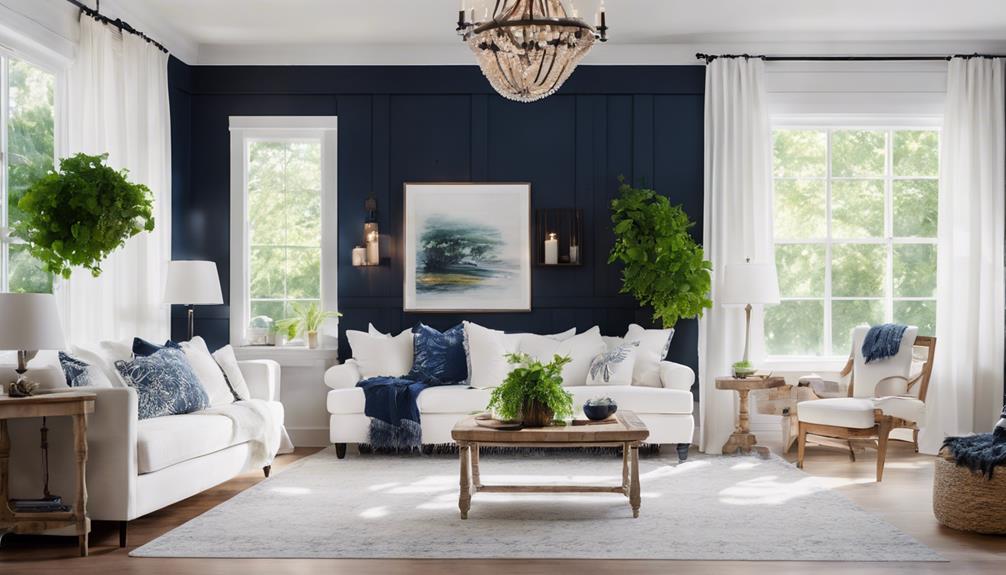
As you explore ways to incorporate navy blue shiplap into your design, consider blending it with other styles to create a unique, eclectic look that showcases your personal taste. By combining navy blue shiplap with other design elements, you can create a space that's truly one-of-a-kind.
Here are a few ways to combine navy blue shiplap with other styles:
- Traditional Twist: Pair navy blue shiplap with traditional elements, like ornate molding or vintage decor, for a classic and charming look.
- Coastal Cool: Mix navy blue shiplap with coastal design elements, like driftwood accents or nautical-themed decor, for a fresh and timeless aesthetic.
- Modern Contrast: Combine navy blue shiplap with modern decor, like sleek lighting fixtures or minimalist furniture, for a sleek and stylish contrast in any room.
When combining styles, don't be afraid to think outside the box. Consider adding a navy blue shiplap accent wall or ceiling to create a bold, eye-catching feature in your space. By blending different styles, you can create a look that's truly unique and reflective of your personal taste.
Elevating Traditional Spaces With Shiplap
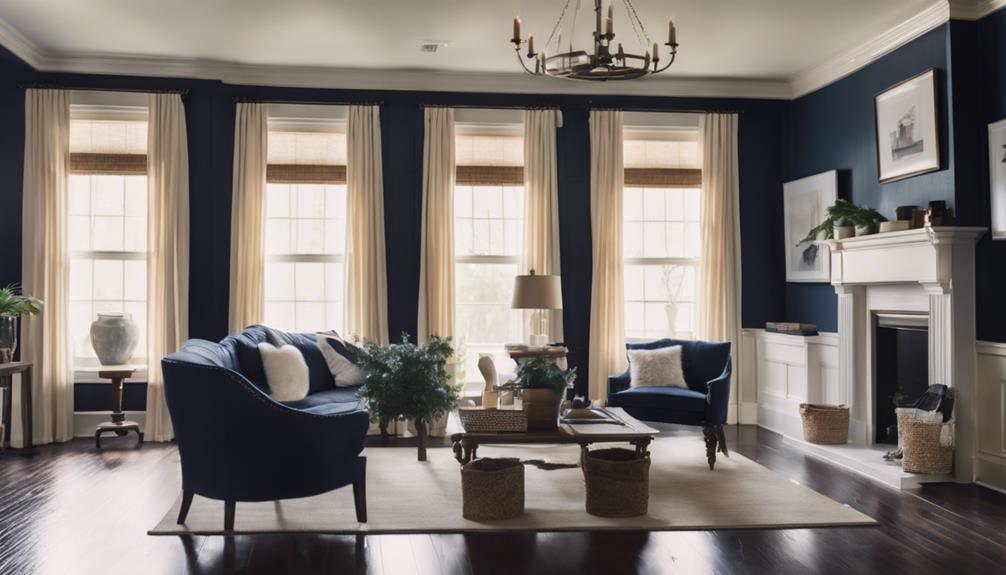
As you consider elevating traditional spaces with navy blue shiplap walls, you'll want to explore how this design element can bring together classic and modern elements.
Add textured interest to your rooms, and create sophisticated accent walls that make a statement.
By incorporating navy blue shiplap, you can achieve a unique blend of timeless elegance and modern flair.
Let's examine how these three key aspects can transform your traditional spaces into something truly remarkable.
Classic Meets Modern Twist
By incorporating navy blue shiplap walls into traditional spaces, you can create a striking visual contrast that seamlessly blends classic and modern elements. This timeless design choice adds sophistication and depth to any room, making it perfect for those who want to elevate their space without sacrificing style.
Here are three reasons why navy blue shiplap walls are a great choice for traditional spaces:
- Sophisticated Backdrop: Navy blue shiplap provides a bold yet elegant backdrop for various decor styles, allowing you to experiment with different design elements.
- Dramatic Flair: The deep navy blue hue adds a touch of drama and richness to the space, enhancing the overall aesthetic.
- Fresh Take on a Classic: The combination of navy blue with traditional shiplap design elements offers a fresh and stylish take on a classic look, perfect for those who want to add a modern twist to their space.
Adding Textured Interest
You can introduce textured interest to your traditional space by incorporating navy blue shiplap walls, which provide a unique visual element that enhances the room's character.
The closely arranged planks of shiplap walls add a tactile quality, creating a sense of depth and visual interest. Navy blue shiplap, in particular, offers a bold yet classic look that elevates traditional spaces.
The texture of these walls can enhance the character and charm of a room, making it feel cozy and inviting. By incorporating navy blue shiplap, you can transform a space, adding a timeless appeal that never goes out of style.
The navy blue hue adds a sense of sophistication, while the shiplap texture provides a rustic touch, creating a beautiful contrast that adds depth to the room. With navy blue shiplap walls, you can create a space that exudes warmth and character, perfect for relaxing and entertaining.
Sophisticated Accent Walls
Navy blue shiplap accent walls inject a dose of sophistication into traditional spaces, effortlessly elevating the room's style and charm. By incorporating this classic design element, you can transform a room into a stylish and inviting space. The deep navy hue creates a striking contrast against the classic white shiplap design, adding depth and character to any room.
Here are three ways navy blue shiplap accent walls can elevate your space:
- Elegant Backdrop: Navy blue shiplap walls provide a timeless and versatile backdrop for various decor styles, allowing you to mix and match furniture and accessories with ease.
- Sophisticated Contrast: The contrast between the navy blue and white shiplap creates a visually appealing combination that adds depth and visual interest to the room.
- Elevated Ambiance: The sophisticated ambiance created by navy blue shiplap accent walls can instantly elevate the mood and atmosphere of the room, making it perfect for relaxing or entertaining.
Shiplap Wall Installation and Care

To achieve a seamless look, fit the wooden planks tightly together, either horizontally or vertically, guaranteeing a polished finish with minimal gaps. This attention to detail will make your navy blue shiplap walls stand out.
When you install shiplap, you can choose to create a unique look by adding a shiplap ceiling to complement your walls. To install shiplap, start by preparing your surface, then measure and cut your planks to fit. Apply a level to ensure straight lines, and use a nail gun to secure the planks to the wall.
After installation, maintain your shiplap walls by regularly dusting or vacuuming to prevent dirt buildup. Occasionally, clean your walls with mild soap and water to keep them looking their best. For added protection, consider sealing or painting your shiplap walls to prevent moisture and stains.
Pairing Navy Blue With Neutral Tones
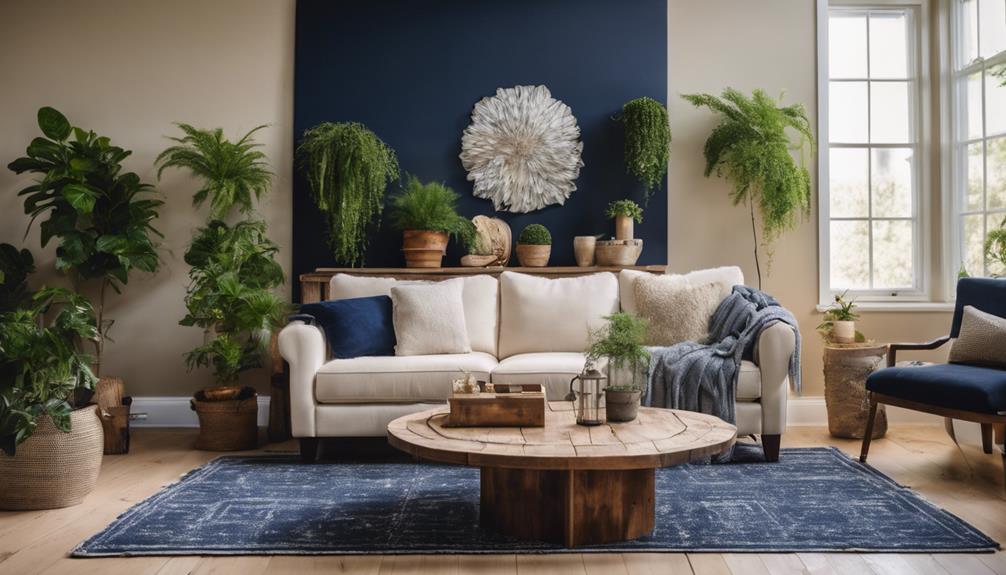
By incorporating neutral tones into your design, you can create a stunning visual harmony that showcases the sophistication of navy blue shiplap walls. The contrast between the deep blue hue and neutral tones creates a sophisticated and elegant feel in any space.
Here are three reasons why pairing navy blue with neutral tones is a winning combination:
- Balanced backdrop: Neutral tones provide a balanced backdrop for navy blue shiplap walls, allowing the deep blue hue to stand out as a focal point.
- Versatility in design: Navy blue and neutral color combinations offer versatility in design, blending seamlessly with various styles and decor elements.
- Visual interest: The combination of navy blue shiplap with neutral tones adds depth, dimension, and visual interest to a room while maintaining a sense of tranquility.
Creating a Focal Point With Shiplap
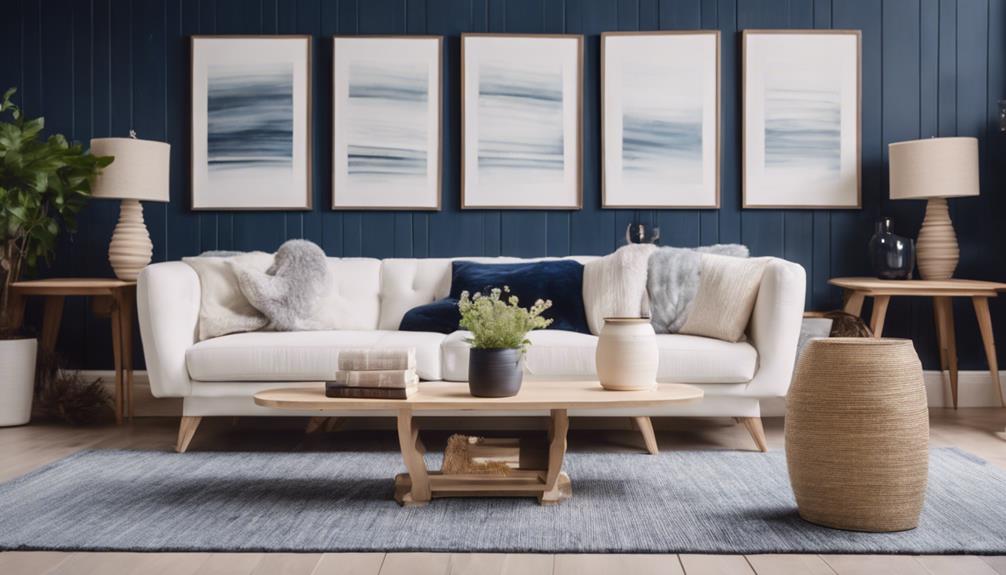
One striking way to create a focal point in your room is to incorporate navy blue shiplap walls, which instantly draw the eye and add depth to the space.
By using shiplap, you're creating a visual anchor that guides the viewer's attention to a specific area of the room. The navy blue color adds a level of sophistication and elegance, making the space feel more luxurious.
You can also use shiplap to accentuate architectural features, such as a statement wall or a fireplace surround, drawing attention to the room's unique characteristics. Additionally, shiplap can be used to highlight built-in shelving or other design elements, adding character to the room.
Timeless Design for Any Home Style
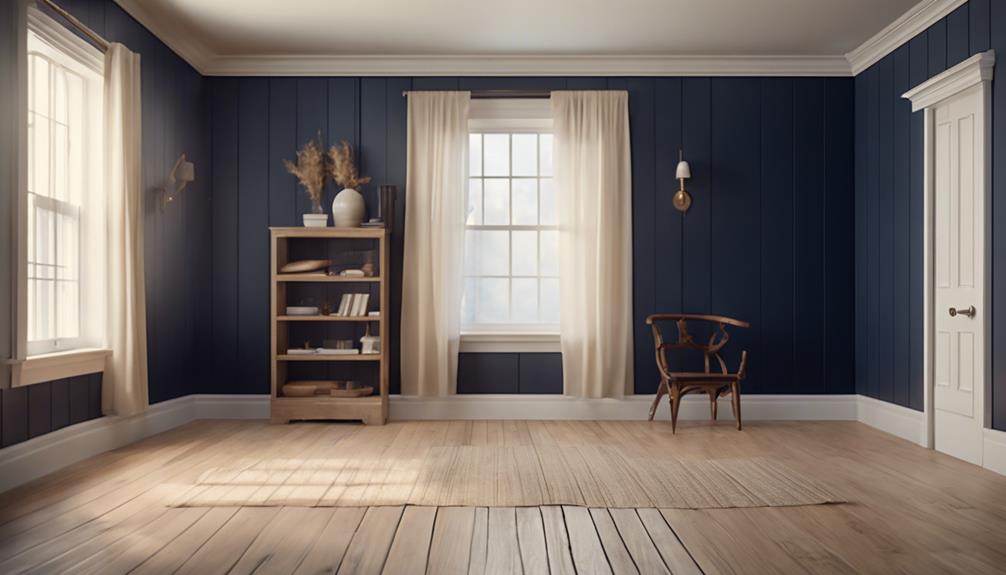
Navy blue shiplap walls effortlessly bring a touch of sophistication to any home style, seamlessly blending with diverse decor elements to create a unique and enchanting space. You can rest assured that this classic design choice will complement your home's aesthetic, regardless of its style. Whether you have a modern, traditional, or eclectic home, navy blue shiplap walls will add a touch of elegance and refinement.
Here are just a few reasons why navy blue shiplap walls are a timeless design choice for any home style:
- Universal appeal: Navy blue shiplap walls complement a wide range of decor styles, from modern to traditional, and everything in between.
- Classic look: The navy blue color adds depth and richness to spaces, providing a stylish and elegant atmosphere that never goes out of style.
- Versatility: Navy blue shiplap walls can serve as a backdrop for artwork, furniture, or other decorative elements in the space, making them a versatile design choice.
Frequently Asked Questions
What Is the Most Timeless Wall Color?
When deciding on the most timeless wall color, you're likely considering options that won't go out of style anytime soon. You've probably narrowed it down to a few neutral shades, but what about a bolder choice?
While whites and creams are classic, a rich, dark hue like navy blue can add sophistication and depth to a room. In fact, navy blue is a versatile color that can blend seamlessly with various design styles and palettes, making it a timeless choice for your walls.
Is Shiplap a Timeless Look?
You might think shiplap is just a fleeting trend, but you'd be surprised to learn that it's actually a timeless look.
Considered a classic design element, shiplap has been popular for centuries, offering a clean, inviting aesthetic that adds warmth and character to any space.
Its versatility and ability to hide imperfections make it a durable and enduring choice, perfect for various home styles and designs.
What Color Is Traditional Shiplap?
You might think traditional shiplap is always white, but that's not the case. While white is a classic choice, traditional shiplap can actually be painted in various colors.
Soft white hues like Cloud White 967 or Swiss Coffee OC-45 are popular options, but you can also opt for darker shades like Hale Navy HC-154 or subtle blues like Mineral Springs CC-848, offering a range of design possibilities.
What Is the Best Color for Shiplap Walls?
As you ponder the perfect hue for your shiplap walls, consider this: the best color is one that harmonizes with your personal style and complements the space's ambiance.
Like a masterful painter, you're searching for the ideal shade to bring your vision to life. While neutrals like white or gray are popular, don't be afraid to think outside the box – or in this case, the shiplap.
Conclusion
To sum up, you've seen how timeless navy blue shiplap walls can elevate your home's style.
Did you know that according to a National Association of Home Builders survey, 60% of homeowners prefer a classic, traditional design style, making navy blue shiplap a great fit?
By incorporating this design element, you'll not only create a stunning visual effect but also tap into a timeless aesthetic that will remain beautiful for years to come.
Vivienne – Your Content Companion Vivienne is your content companion, curating valuable tips, advice, and inspiration to guide you on your home decor journey. From insightful blog posts to informative product descriptions, she’s here to empower you with the knowledge you need to create your dream space.
Home Decor
What Are Indonesia’s Sustainable Rural Design Trends?
What are Indonesia’s sustainable rural design trends that integrate traditional knowledge and modern practices, and how do they shape the future of local communities?
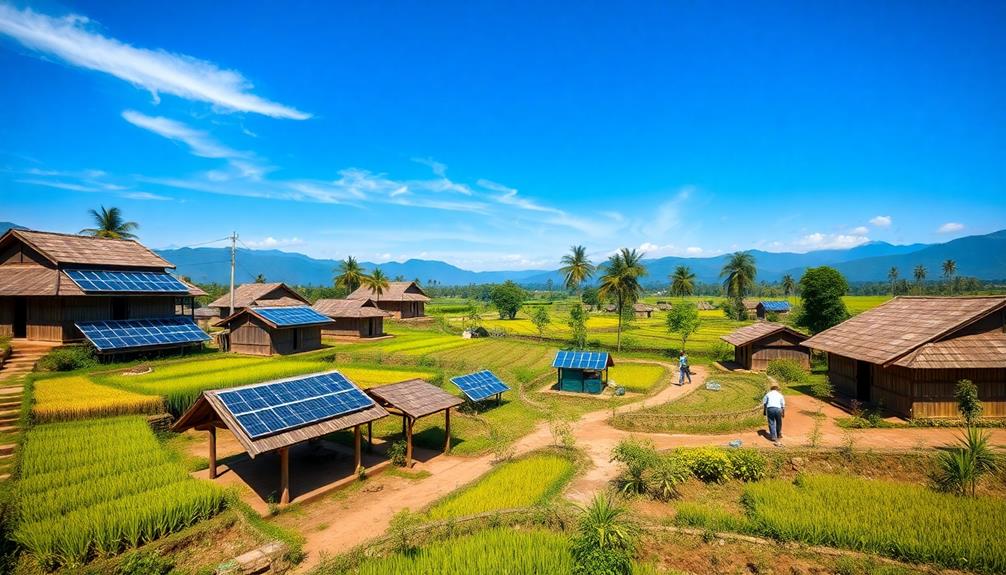
Indonesia's sustainable rural design trends focus on integrating Traditional Ecological Knowledge (TEK) with modern approaches to enhance community resilience. You'll see participatory design methods empowering locals as co-designers, ensuring that their unique needs are met. Initiatives like the Taba Padang village's forest scheme promote sustainable farming while preserving biodiversity. Engagement strategies emphasize collaboration, fostering social innovation and ownership. These trends not only enrich local identity but also improve economic prospects through sustainable practices, like cultivating traditional crops. There's so much more to explore about Indonesia's journey toward sustainability, and these trends are just the beginning.
Key Takeaways
- Integration of Traditional Ecological Knowledge (TEK) enhances sustainable farming practices and aligns agriculture with ecological cycles in rural communities.
- Community-driven initiatives, such as village forest schemes, promote biodiversity and prevent deforestation while improving crop yields.
- Participatory design empowers local residents to co-create sustainable solutions, fostering community engagement and ownership in development projects.
- Ethnographic methods document local cultural practices, ensuring that design outcomes reflect unique community identities and needs.
- Increased market access through improved transportation, like motorbikes, supports economic development and sustainable livelihoods for rural farmers.
Impact of Industrialization and Urbanization
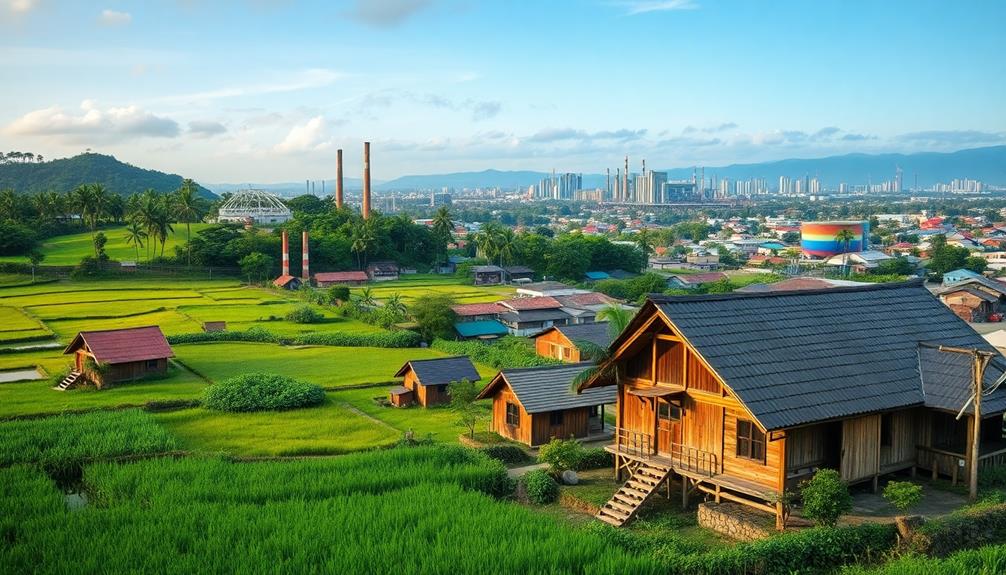
The rapid industrialization and urbanization in Indonesia have profoundly reshaped rural communities and their traditional farming practices. Since the Green Revolution in 1968, mechanized farming techniques have taken root, greatly reducing biodiversity in rural areas.
You may find that the vibrant cultural expressions, such as the Indonesian Decor Mask, are increasingly at risk as these changes take hold. You've likely noticed how urbanization policies have deepened the economic divide, exploiting rural resources and pushing poverty levels higher—12.36% of the rural population faced this challenge as of September 2022.
This shift towards profit-driven, efficient farming hasn't only led to ecological degradation but also eroded cultural practices central to these communities' identities.
As you observe these changes, it's clear that sustainable development is essential for the future of rural Indonesia. Integrating Traditional Ecological Knowledge (TEK) into modern agricultural practices can foster resilience in these communities.
TEK embodies local wisdom and ecological balance, offering invaluable insights that modern methods often overlook. By embracing sustainable design practices that honor these traditions, you can help mitigate the vulnerabilities faced by rural areas, ensuring that their unique cultural heritage and ecological health are preserved.
This approach not only benefits the environment but also strengthens community ties and identity.
Participatory Design and Co-Creation
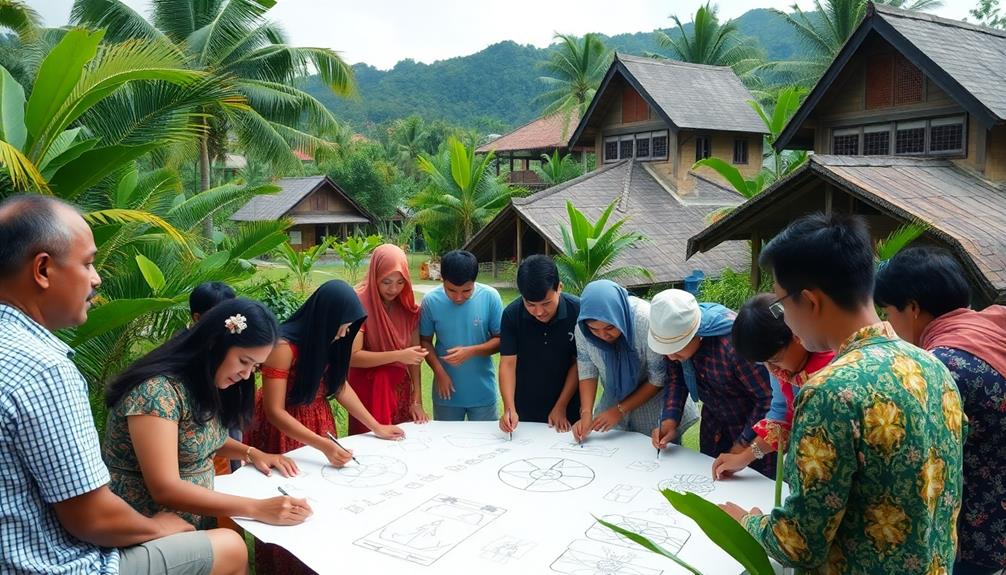
While rural communities in Indonesia face significant challenges from industrialization and urbanization, participatory design and co-creation offer a pathway to empower local residents. This approach emphasizes active involvement, treating community members as co-designers. It fosters social transformation and sustainability by engaging locals in decision-making processes, which is vital as these communities navigate the pressures of modern housing trends and the need for cultural preservation, as seen in the traditional and modern elements of Indonesian housing.
The participatory design process includes five key activities: initiation meetings, treasure mapping, idea generation, craft design workshops, and project reflection. These activities guarantee that everyone's voice is heard, allowing you to contribute to the outcomes that affect your life. Ethnographic methods document local perspectives and cultural activities, reflecting the unique needs and identities of your community.
Co-creation of knowledge enhances local narratives, empowering you and your neighbors to make collective decisions. By integrating Traditional Ecological Knowledge (TEK) into participatory design practices, you strengthen community empowerment and environmental stewardship.
This connection fosters a deeper understanding of sustainable practices that benefit both your community and the environment.
Role of Traditional Ecological Knowledge

Harnessing Traditional Ecological Knowledge (TEK) in Indonesia reveals the invaluable insights local communities possess about their environment and sustainable practices. TEK emphasizes local wisdom, like Niteni, which encourages observing natural phenomena to guide sustainable farming activities.
This approach mirrors the principles found in traditional Indonesian housing, where local materials and ecological awareness shape building practices. By applying the Pranatamangsa system, farmers align their agricultural practices with ecological cycles, enhancing their yields while ensuring sustainability.
Incorporating TEK into modern participatory design practices not only enriches community identity but also fosters pride, driving local engagement in sustainable development initiatives.
This approach promotes environmental stewardship by preserving traditional crop varieties and agricultural methods that are more resilient to climate change.
Community Engagement Strategies

Building on the foundation of Traditional Ecological Knowledge (TEK), community engagement strategies in Indonesia focus on involving local residents as active participants in the design process. This participatory approach encourages you to become a co-designer, fostering social innovation and sustainable development within your community.
For instance, incorporating elements of Indonesian Decorative Pillows can enhance living spaces while reflecting local culture and craftsmanship. In places like Sabrang Village, ethnographic methods help document local cultural practices, ensuring your perspectives and identities shape the design outcomes.
Collaborative workshops bring together local community members and external stakeholders—58 participants in total—to enhance engagement and ownership in development projects. By integrating TEK into these practices, you empower your community with local wisdom and sustainable agricultural methods that promote environmental stewardship.
Moreover, the co-creation of knowledge through participatory learning enriches local narratives, allowing you and your neighbors to collectively tackle challenges and support sustainable regional development.
Case Studies of Sustainable Practices
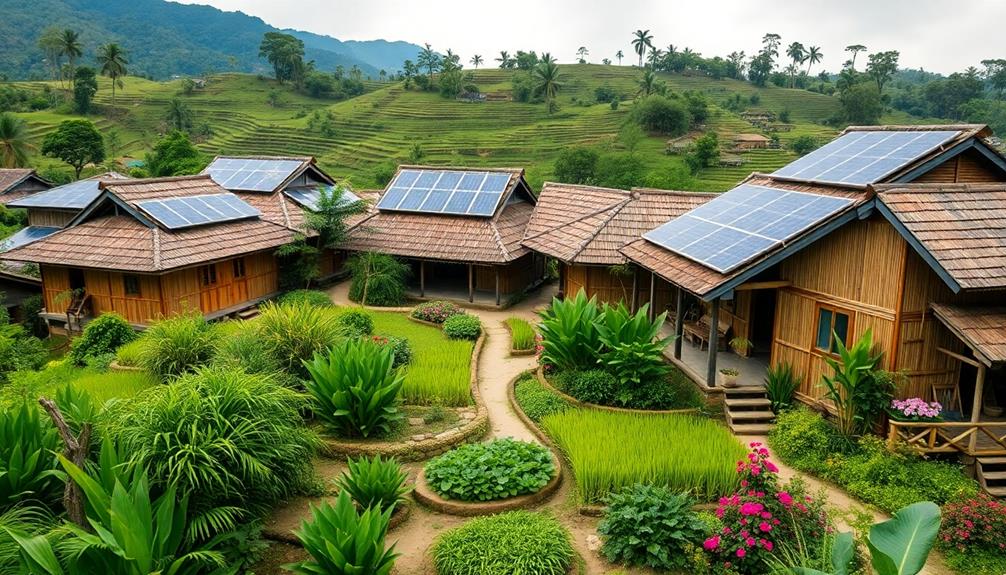
Sustainable practices in Indonesia showcase the transformative power of community-driven initiatives, especially in rural areas. Take Taba Padang village in southwest Sumatra, for example. Here, 470 households have embraced a village forest scheme, managing 1.5 hectares each in a protected forest. This approach promotes sustainable crop growth while preventing deforestation, allowing for the incorporation of local cultural elements into the farming practices, such as traditional planting techniques and community celebrations.
As a result, the community has seen increased incomes from cultivating coffee, pepper, durian, and rattan, which can be further enhanced through events that highlight their unique agricultural products Indonesian Party Decorations.
The introduction of motorbikes for harvest transportation has further improved farming operations, enhancing access to markets and making it easier for farmers to sell their products. Taba Padang's commitment to environmental conservation is evident in their shift from deforestation to reforestation. Regular inspections guarantee everyone adheres to sustainable practices, fostering a sense of responsibility within the community.
Recognized by the Indonesian Ministry of Environment and Forestry, Taba Padang's achievements highlight the potential for eco-tourism, thanks to its natural attractions like waterfalls and hot springs. This case study exemplifies how rural communities can thrive sustainably while protecting the environment, serving as a model for others looking to implement similar practices.
Frequently Asked Questions
What Are the Sustainability Plans of Indonesia?
Indonesia's sustainability plans focus on integrating smart village concepts and renewable energy projects. You'll see initiatives like the Emission Trading Scheme and carbon trading platforms aimed at enhancing community resilience and promoting environmental responsibility.
Why Are Rural Areas More Sustainable?
Imagine a thriving garden, where every plant shares its resources. In rural areas, community ties and traditional knowledge foster sustainability, allowing you to nurture the land and its diversity while ensuring a balanced, harmonious existence.
Conclusion
In Indonesia, the convergence of industrialization and a deep-rooted respect for traditional ecological knowledge creates a unique landscape for sustainable rural design. By embracing participatory design and community engagement, you're not just witnessing a trend; you're part of a transformative movement. Coincidentally, as rural areas adapt to modern challenges, they also revive age-old practices, illustrating that sustainability isn't merely a goal but a harmonious blend of past wisdom and present innovation, shaping a brighter future for all.
Home Decor
Emerging Sustainable Trends in Rural Design
Get ready to discover how innovative sustainable trends in rural design are transforming communities, but what groundbreaking practices are leading the way?
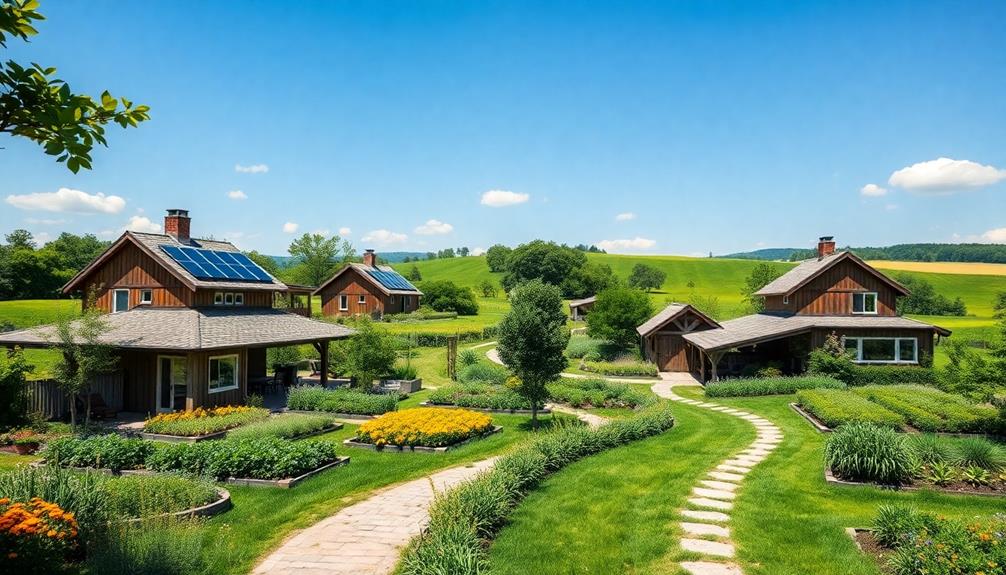
Emerging sustainable trends in rural design focus on eco-friendly practices that promote community resilience and environmental health. By integrating renewable energy solutions like solar panels, you enhance energy independence while reducing costs. Using local, natural materials supports economies and minimizes transportation emissions. Implementing water conservation techniques addresses resource scarcity effectively. Community-centric planning guarantees developments meet local needs and values, fostering social cohesion. Innovations in agriculture, such as precision farming, improve yields and sustainability. These trends not only uplift local economies but also enhance well-being. Keep exploring to uncover even more transformative practices reshaping rural landscapes today.
Key Takeaways
- Sustainable rural design emphasizes renewable energy integration, enhancing energy independence and reducing reliance on non-renewable sources.
- Community-centric planning practices ensure developments resonate with local needs and values, fostering social cohesion and quality of life.
- Nature-inspired design approaches enhance aesthetics and sustainability through passive solar design, green spaces, and local materials.
- Resource efficiency strategies, such as rainwater harvesting and locally sourced materials, significantly reduce waste and operational costs.
- Innovations in agriculture and renewable energy, like organic farming and micro-hydroelectric systems, boost local economies and promote ecological balance.
Overview of Sustainable Rural Design
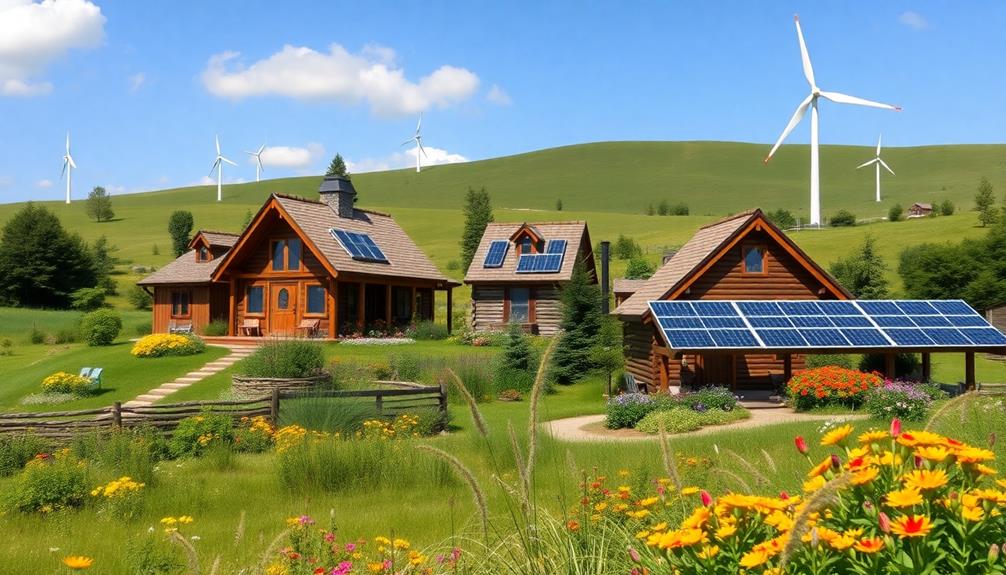
Sustainable rural design is increasingly becoming essential for creating resilient communities that thrive while respecting the environment. By integrating renewable energy solutions like solar panels and wind turbines, you can enhance energy independence in rural areas. These sources not only reduce reliance on fossil fuels but also lower energy costs over time.
Incorporating natural materials, similar to Balinese design characteristics, can further enhance sustainability and create a warm, inviting atmosphere. Using locally sourced materials such as compressed earth blocks can greatly reduce construction expenses while supporting local economies. This approach promotes sustainable living practices that benefit both the community and the environment.
Additionally, implementing water conservation techniques, including rainwater harvesting and greywater recycling, addresses pressing water scarcity issues effectively. Incorporating biophilic design principles into rural structures fosters a connection with nature, enhancing the well-being of occupants through green spaces and natural light.
You'll find that innovative housing solutions, like modular homes, offer cost-effective and energy-efficient options. These designs minimize construction waste and time while promoting eco-friendly practices.
Key Principles of Ecological Design
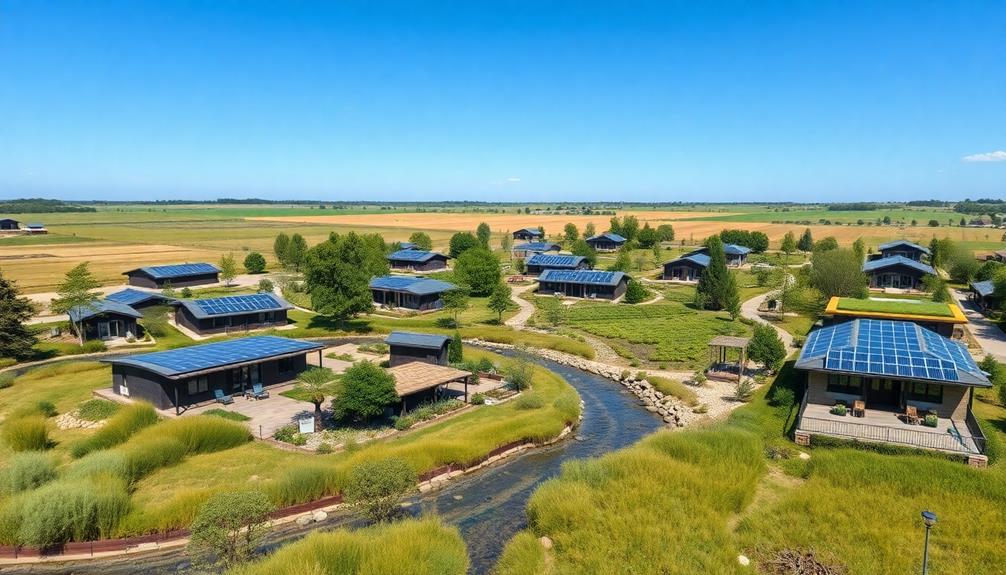
When you think about ecological design, consider how nature-inspired approaches can shape your projects.
Emphasizing harmony with nature, as seen in traditional Indonesian style home decor, can enhance the aesthetic while promoting sustainability.
You'll want to focus on resource efficiency strategies that minimize waste and maximize sustainability.
Plus, incorporating community-centric planning practices guarantees that your designs truly reflect the needs and values of the people living in those spaces.
Nature-Inspired Design Approaches
Embracing nature-inspired design approaches can transform rural architecture into vibrant, sustainable spaces that harmonize with their surroundings. By prioritizing biomimicry, you can emulate natural forms and processes, creating efficient structures that work seamlessly with ecosystems.
These sustainable architecture practices often utilize local materials and traditional building techniques, such as those found in traditional Indonesian housing, which reduce carbon footprints and celebrate cultural heritage.
Key elements of nature-inspired design include:
- Passive solar design: Optimize building orientation and thermal mass to cut energy consumption.
- Ecological design: Integrate green spaces and native landscaping to enhance biodiversity and improve air quality.
- Water management strategies: Implement natural ponds and rain gardens for effective water conservation.
- Local materials: Use materials sourced from nearby to minimize transportation emissions.
- Wildlife habitats: Create environments that support local fauna, promoting ecological balance.
Resource Efficiency Strategies
Resource efficiency strategies play a pivotal role in ecological design, building on the foundation of nature-inspired approaches. By prioritizing locally sourced materials, you can greatly reduce transportation emissions while supporting local economies.
For example, incorporating elements from traditional Indonesian wedding decor ideas can enhance community connections through locally sourced floral arrangements and handcrafted decor. Take, for instance, the rising popularity of compressed earth blocks and bamboo construction—these options embody sustainable choices.
Implementing rainwater harvesting systems and greywater recycling is another effective strategy. You could reduce water consumption by up to 50%, promoting sustainable water use in your community.
Furthermore, integrating renewable energy sources like solar panels and small wind turbines not only enhances energy independence but can also cut household energy costs by 30-50%.
Utilizing passive solar design techniques, such as strategic building orientation and thermal mass, helps you maximize natural heating and cooling, potentially reducing energy use for temperature regulation by 20-40%.
Additionally, embracing eco-friendly product designs, like low-cost cooking stoves and efficient irrigation systems, can lower resource consumption and operational costs.
These strategies collectively improve the quality of life for rural residents, making your community more sustainable and resilient in the long run.
Community-Centric Planning Practices
Community-centric planning practices are essential for fostering sustainable rural development that truly reflects the needs and values of local residents. By prioritizing community engagement and participatory design, you can guarantee that developments resonate with the people who'll use them.
Significantly, traditional Indonesian houses, such as Rumah Adat, emphasize community-oriented layouts that encourage social interaction and a sense of belonging. Studies have shown that this approach can lead to a 30% increase in community satisfaction.
Utilizing ecological design principles, such as:
- Incorporating local materials to reduce emissions and costs
- Designing green spaces that boost social cohesion and safety
- Integrating renewable energy solutions for economic resilience
- Promoting sustainable agricultural practices to enhance biodiversity
- Creating shared public areas that foster community interaction
These strategies not only support economic development but also enhance the quality of life in rural areas.
For instance, using compressed earth blocks can cut construction costs by 20%, while renewable energy solutions can reduce energy costs by 50%. By focusing on sustainable practices, you can create vibrant, thriving communities that prioritize both ecological health and resident well-being.
Embracing these community-centric approaches guarantees a holistic development model that benefits both people and the planet.
Community-Centric Planning Approaches
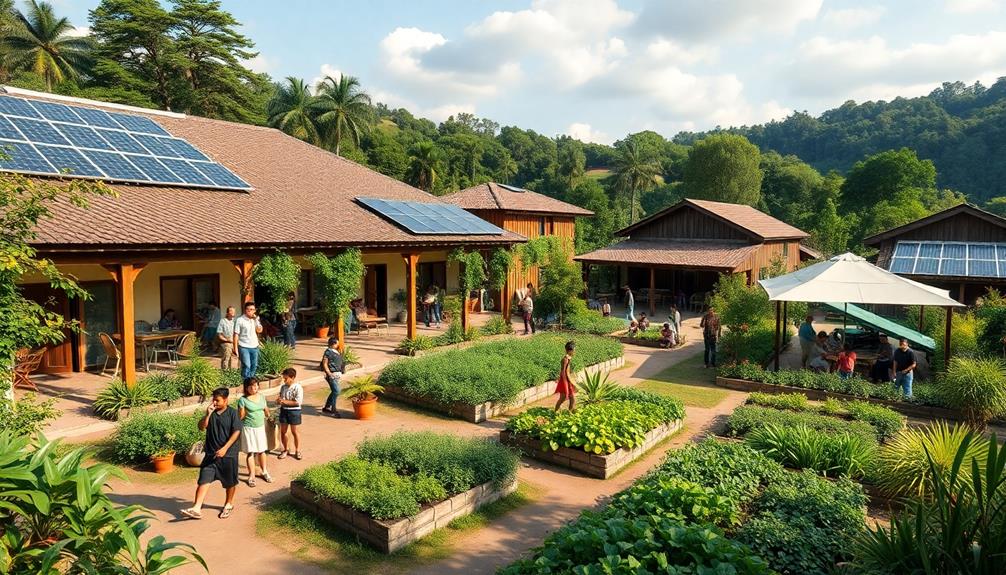
When you embrace participatory design methods, you empower your community to shape its own future.
Incorporating elements of local culture, such as Indonesian Decorative Pillows, can enhance the sense of identity and belonging among residents.
Engaging local residents not only enhances their connection to the area but also guarantees that developments truly reflect their needs and values.
Participatory Design Methods
Participatory design methods empower residents to take an active role in shaping their environment, guaranteeing that projects align with local needs and values. By engaging community members in the planning process, you foster a sense of community ownership and pride.
This approach can also reflect local craftsmanship, similar to how the intricate designs of Indonesian decor masks enhance cultural appreciation in various settings. Studies show that projects that involve local input are 30% more likely to be accepted and utilized, creating sustainable solutions that truly reflect the community's unique characteristics.
Here are some key aspects of participatory design:
- Inclusivity: Engaging diverse backgrounds guarantees all voices are heard.
- Workshops: Collaborative sessions allow community members to share their ideas.
- Cultural relevance: Designs become contextually appropriate, reflecting local traditions.
- Social cohesion: Strengthening relationships among residents improves overall quality of life.
- Empowerment: Community members gain confidence in their ability to influence change.
Enhancing Local Engagement
Engaging local residents in the planning process not only builds on the principles of participatory design but also fosters a deeper connection to the projects that shape their environment.
When you prioritize community input, you guarantee developments reflect local traditions and values, enhancing inclusivity. This approach cultivates a sense of ownership, making residents more likely to embrace and utilize community projects.
By integrating elements of tropical architecture that resonate with local culture, such as open spaces and natural light, you can further enhance the sense of belonging within the community.
Involving diverse stakeholders, including marginalized groups, promotes social cohesion and addresses historical disparities in rural development.
By integrating local knowledge, you're more likely to identify unique environmental and social considerations that standard practices might overlook, leading to sustainable outcomes.
Moreover, successful community engagement has been linked to improved mental health and well-being.
When you strengthen social networks and create spaces that encourage interaction, you support community activities that enhance overall quality of life.
Innovations in Renewable Energy

Rural areas are witnessing a surge in renewable energy innovations that are transforming how communities power their lives. By investing in sustainable energy sources, you can enhance energy independence and greatly reduce greenhouse gas emissions.
For instance, solar energy is projected to account for about 20% of global electricity generation by 2040, making it a key player in rural energy strategies. The emphasis on sustainable craftsmanship in Balinese furniture also reflects a growing trend towards eco-friendly practices in various sectors.
Consider the benefits of these innovations:
- Micro-hydroelectric systems: Harness flowing water to create decentralized energy solutions, cutting costs by up to 30%.
- Solar-powered irrigation systems: Boost agricultural efficiency, potentially increasing crop yields by 20-30%.
- Wind energy projects: Provide reliable power while supporting local job opportunities in the renewable energy sector.
- Energy independence: Reduces reliance on non-renewable sources, allowing rural communities to thrive sustainably.
- Economic growth: The renewable energy sector is expected to create over 24 million jobs globally by 2030.
Sustainable Agriculture Practices

Sustainable agriculture practices are revolutionizing how we produce food while minimizing environmental impact. By focusing on efficient resource management and innovative techniques, these practices not only enhance food production but also promote biodiversity conservation. You can see how various methods contribute to sustainable food sources in the table below:
| Practice | Benefits |
|---|---|
| Organic Farming | Reduces chemical use |
| Precision Farming | Increases crop yields by 20-30% |
| Agroecological Practices | Enhances ecosystem health |
| Water Management Innovations | Cuts water usage by up to 30% |
| Local Seasonal Production | Supports food security in rural communities |
Adopting these sustainable agriculture practices addresses critical challenges, including water scarcity and the need for food security. By emphasizing local food production, you can strengthen rural economies and foster community resilience. As the organic farming market is projected to reach $500 billion by 2025, it's clear that the shift toward sustainability is not just beneficial but essential for our future. Embrace these practices to help create a more sustainable world.
Enhancing Local Economies
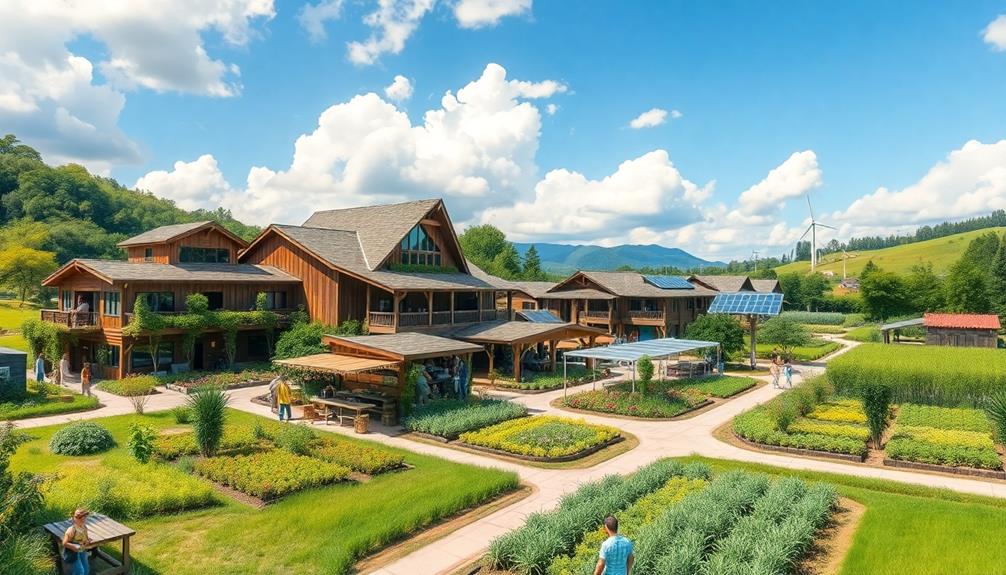
Investing in sustainable agriculture practices not only boosts food production but also lays the groundwork for enhancing local economies. By focusing on rural development, you're supporting initiatives that contribute around 30% to global GDP.
Additionally, incorporating elements of traditional artistry, such as Indonesian decor masks, can celebrate local culture and attract tourism, further promoting economic growth. This investment fosters economic growth and diversifies income sources, as non-farm activities now account for up to 50% of rural income in some areas.
Consider the following strategies to enhance local economies:
- Support renewable energy projects that create jobs and reduce dependency on non-renewable sources.
- Encourage sustainable entrepreneurship by providing training and resources for local business owners.
- Promote infrastructure investment, such as improved transportation networks, to enhance market access for local products.
- Expand access to financial services, including microfinance options, to empower entrepreneurs and stimulate economic development.
- Develop community programs that foster collaboration and knowledge-sharing among local businesses.
These sustainable practices not only improve the quality of life in rural areas but also create a robust ecosystem that drives long-term economic stability.
Health and Well-being in Design
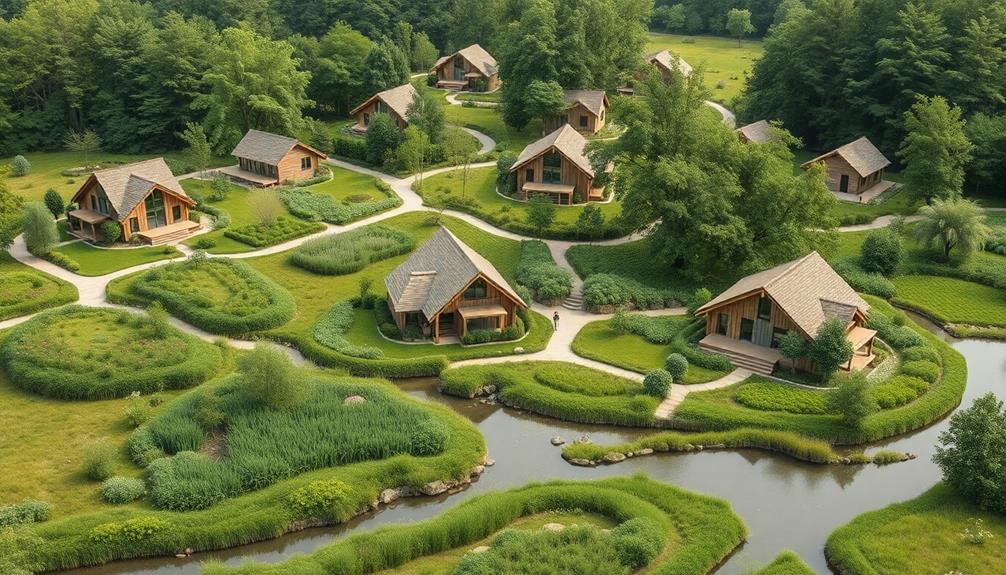
There's a growing recognition that the design of our living spaces greatly impacts health and well-being. By integrating biophilic design principles, you can create environments that foster mental well-being and reduce stress. Access to green spaces not only enhances air quality but also encourages physical activity, leading to improved physical health outcomes.
Natural light and proper ventilation are essential in rural homes, enhancing indoor comfort and productivity. Additionally, using eco-friendly materials minimizes indoor air pollutants, creating a healthier living environment. Community engagement is significant as it helps foster social connections, enhancing a sense of belonging that is fundamental for mental health.
Here's a quick summary of these key aspects:
| Design Element | Benefits |
|---|---|
| Biophilic Design | Reduces stress, boosts mental well-being |
| Access to Green Spaces | Improves air quality, enhances physical health |
| Natural Light | Increases comfort and productivity |
| Eco-Friendly Materials | Lowers indoor pollutants for healthier living |
Incorporating these elements not only promotes individual well-being but also strengthens community ties, ultimately leading to a healthier rural lifestyle.
Future Directions for Rural Development
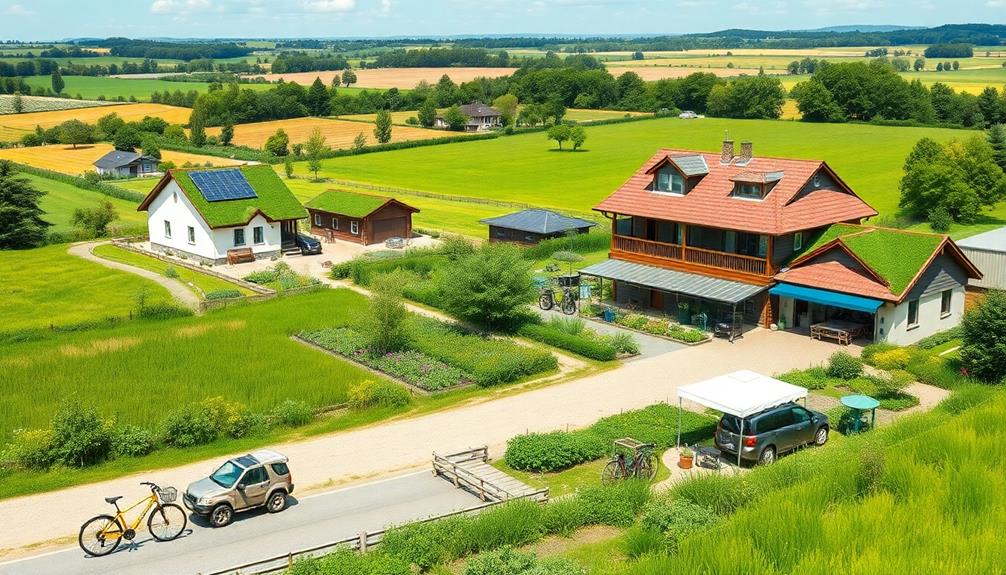
As rural development evolves, a clear focus on sustainable agriculture practices will shape the future landscape of these communities.
You'll see an increasing emphasis on innovative solutions that enhance food security and drive economic growth. The organic farming market, projected to reach $500 billion by 2025, is just one example of how sustainable development can transform rural areas.
Consider these key trends that will define future rural development:
- Investment in infrastructure: Improved transportation and utilities will create better access to markets.
- Precision farming technologies: These advancements promise to boost crop yields by 20-30%, optimizing natural resources.
- Rural entrepreneurship: Non-farm activities can contribute up to 50% of rural income, fostering innovation and job creation.
- Energy efficiency initiatives: Adopting eco-friendly living practices will reduce waste and enhance sustainability.
- Access to education: Educational programs will empower residents, equipping them with skills for new employment opportunities.
As you engage with these developments, you'll witness a more resilient and sustainable future for rural communities, ultimately leading to a thriving, eco-friendly lifestyle.
Frequently Asked Questions
What Are the Examples of Sustainable Development in Rural Areas?
You'll find examples of sustainable development in rural areas like renewable energy projects, organic farming, eco-friendly modular housing, community-driven design, and innovative water management systems, all enhancing local independence, efficiency, and environmental conservation.
How to Promote Sustainability in Rural Areas?
Imagine a future where your community thrives—by adopting renewable energy, sustainable agriculture, eco-friendly housing, and efficient water management. You can engage locals, ensuring their needs shape projects, fostering lasting change and shared ownership of a sustainable tomorrow.
What Are the Sustainable Development Goals of Rural Development?
The sustainable development goals for rural development focus on eradicating poverty, ensuring food security, managing water resources, promoting economic growth, and enhancing urban-rural connections. You'll play a key role in achieving these goals through local initiatives.
What Are the Challenges of Rural Sustainability?
Rural regions wrestle with resource restraints, aging populations, and climate changes. You'll face fragmented infrastructure and limited community involvement, making it tough to tackle sustainability challenges effectively and foster vibrant, resilient rural futures.
Conclusion
As you embrace these emerging sustainable trends in rural design, you'll cultivate greener landscapes, nurture stronger communities, and inspire healthier lifestyles. By prioritizing ecological principles, harnessing renewable energy, and supporting local economies, you'll create vibrant spaces that thrive today and tomorrow. Picture thriving farms, bustling markets, and interconnected neighborhoods, all blossoming under the sun of sustainability. Together, let's pave the way for a brighter, more resilient rural future, where nature and community flourish hand in hand.
Home Decor
Sustainable Rural Design Trends Shaping Indonesia
Uncover how sustainable rural design trends in Indonesia are transforming communities and preserving cultural heritage, creating a brighter future for its residents.
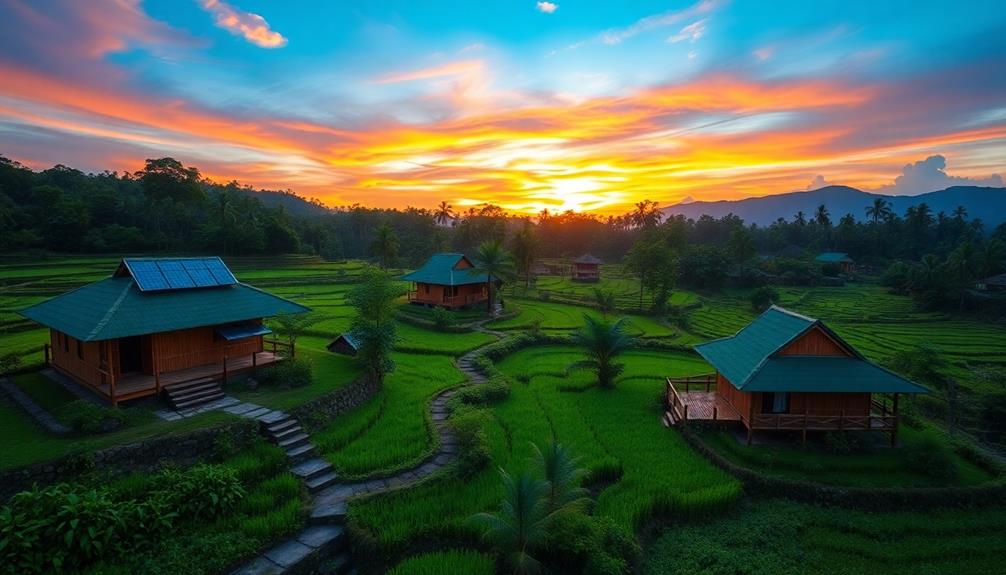
In Indonesia, sustainable rural design trends are transforming communities while respecting cultural heritage. You'll see a strong focus on participatory design, where locals co-create their environments, empowering them and preserving their identities. Traditional Ecological Knowledge plays a crucial role, guiding farming practices and promoting ecological balance. This approach not only fosters local pride but also boosts sustainable tourism, which generates economic benefits. Areas like Sabrang Village illustrate these principles, combining natural materials and local craftsmanship. Discover how these trends are shaping the future of rural Indonesia and enhancing the lives of its residents.
Key Takeaways
- Participatory design engages local residents as co-designers, fostering community identity and ensuring designs meet local needs.
- Traditional ecological knowledge (TEK) enhances sustainability and preserves regional identity through culturally rooted practices and natural observations.
- Case studies like Sabrang Village demonstrate successful integration of traditional craftsmanship and modern design principles for economic growth and community involvement.
- Sustainable tourism initiatives leverage cultural heritage, attracting visitors while boosting local economies and promoting environmental conservation.
- Emphasizing community engagement and ecological balance is crucial for revitalizing rural areas and addressing the impacts of industrialization.
Impact of Industrialization on Rural Areas

Industrialization has drastically altered the landscape of rural Indonesia, impacting both livelihoods and cultural traditions. You've likely noticed how mechanized farming methods have replaced traditional agricultural practices, leading to a significant loss of local biodiversity since the Green Revolution in 1968. This shift not only threatens the ecological balance but also diminishes the rich cultural practices tied to farming communities.
Traditional Indonesian housing, often designed to reflect the local environment and cultural values, is also at risk as modernization takes hold, with many communities losing their architectural heritage as a result of urbanization and economic pressures traditional homes and cultural symbolism.
Urbanization policies have exacerbated economic disparities, leaving rural areas struggling. With a rural poverty rate of 12.36% as of September 2022, many rural communities face increasing unemployment and school dropout rates. The focus on profit and efficiency in modern agriculture often neglects the needs of these communities, fueling social change that further isolates them from their cultural roots.
In this landscape, the necessity for sustainable development becomes clear. Supporting design practices that honor traditional methods while promoting ecological balance is essential for revitalizing rural areas. By fostering community engagement and sustainable practices, you can help bridge the gap between industrialization and the preservation of Indonesia's rich cultural heritage, creating a more equitable future for rural communities.
Participatory Design in Community Development
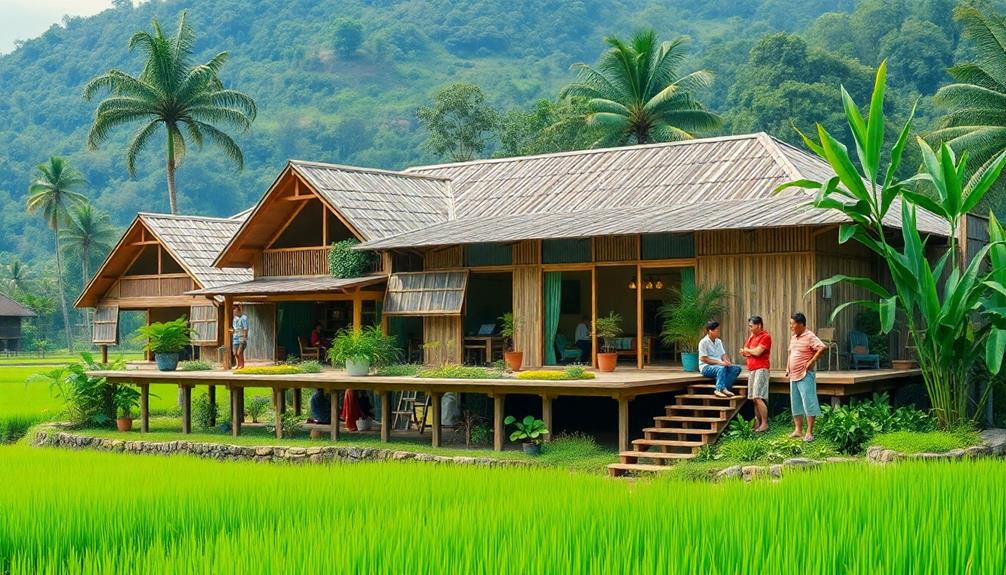
Participatory design transforms community development by actively engaging local residents as co-designers in the process. This approach empowers you and your neighbors, enhancing local narratives and identities while fostering collective decision-making.
By incorporating elements of Indonesian decorative pillows into community spaces, designs can reflect cultural heritage and enhance aesthetics. Through a structured process that includes initiation meetings, treasure mapping, idea generation, craft design workshops, and project reflection, participatory design guarantees thorough community engagement.
Employing ethnographic methods allows for a deep understanding of your community's life and cultural activities, resulting in designs that truly reflect local perspectives and needs. By involving you and your fellow community members in experiential learning, this method supports social innovation and sustainable development, addressing both human and ecological needs.
A recent project showcased the power of diverse collaboration, with 58 participants, including 24 local community members and 28 external stakeholders. This highlights the importance of engaging all voices in the community.
Ultimately, participatory design not only builds a sense of ownership among residents but also leads to solutions that are more viable and relevant. As you participate, you're not just contributing to a project; you're helping shape the future of your community.
Role of Traditional Ecological Knowledge
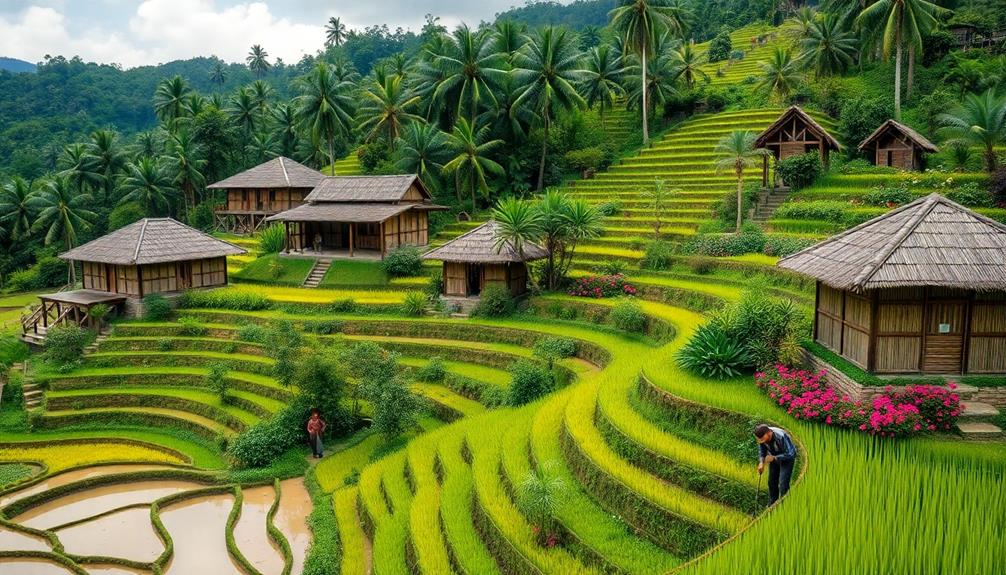
Harnessing the wisdom of Traditional Ecological Knowledge (TEK) is essential for achieving sustainable development in Indonesia. TEK reflects local cultural practices that promote ecological balance and sustainability. By observing natural phenomena through Niteni, farmers adapt their agricultural activities based on seasonal guidelines, enhancing yields while respecting the environment.
| TEK Element | Impact | Community Benefit |
|---|---|---|
| Seasonal Guidelines | Aligns farming with cycles | Increases agricultural resilience |
| Heritage Preservation | Maintains regional identity | Fosters local pride |
| Sustainable Tourism | Promotes eco-friendly travel | Boosts local economy |
Incorporating TEK into participatory design practices empowers communities and strengthens local wisdom. This co-creation of knowledge respects cultural identities and enhances regional development. By integrating these practices, you not only support sustainable tourism initiatives but also create a foundation for long-term ecological stewardship. Embracing TEK is a powerful way to guarantee that Indonesia's rich heritage thrives alongside modern advancements, creating a harmonious future for both the environment and its people.
Social Design and Community Engagement
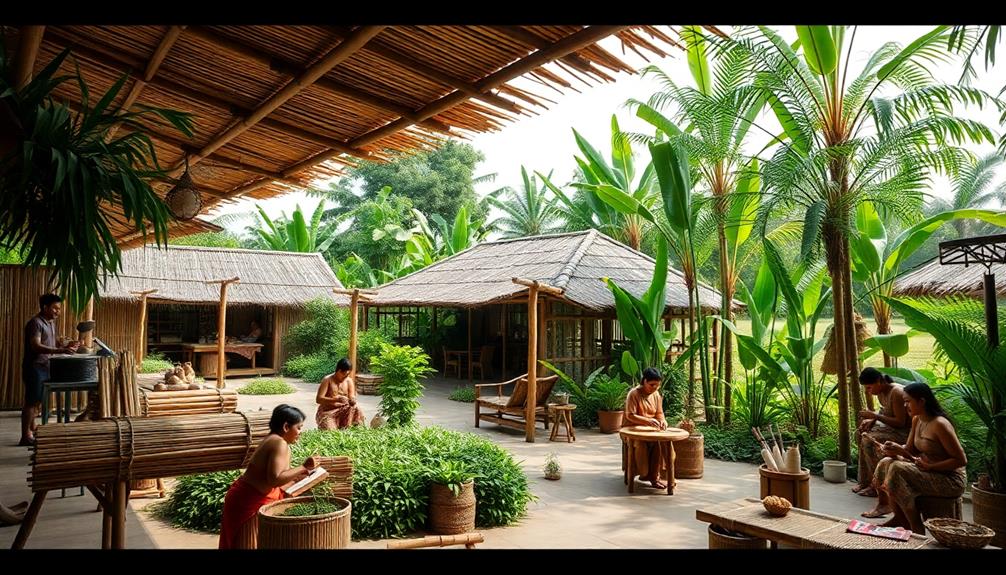
Building on the foundation laid by Traditional Ecological Knowledge, social design plays an essential role in fostering community engagement in rural Indonesia. This approach emphasizes openness and connectedness, driving social innovation and inspiring local communities to collaborate effectively.
By employing participatory design, you actively involve stakeholders, treating them as co-designers. This not only enhances community empowerment but also promotes sustainable regional development. Traditional Indonesian houses, known for their community-oriented layout, further underscore the importance of collaboration and social interaction within these rural settings, reflecting the cultural significance of housing.
Engagement in projects, like one involving 58 participants, highlights how regular consultations with local farmers and government representatives facilitate knowledge exchange and collective decision-making, vital for effective rural development.
Ethnographic methods capture community life and cultural activities, ensuring local perspectives inform design processes and strengthen cultural identity.
Moreover, community engagement through participatory learning encourages experiential knowledge acquisition, equipping residents with the skills necessary for resilience in rural areas.
As you immerse yourself in these processes, you'll realize that social design isn't just about creating structures or systems; it's about empowering communities to shape their environment.
Case Study: Sabrang Village Insights
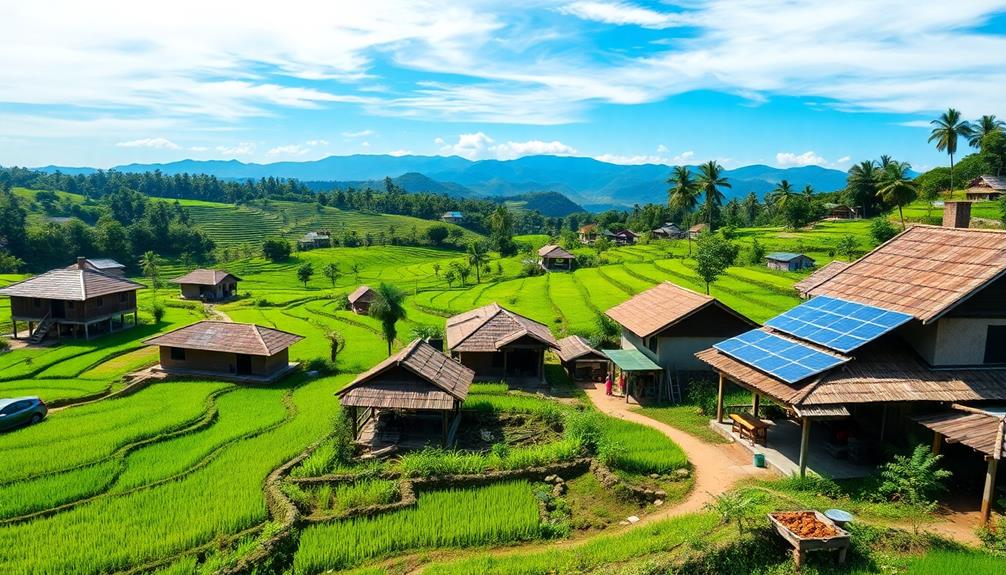
Sabrang Village stands out as a vibrant example of sustainable rural design in Indonesia, where local farmers cultivate rice varieties like Rojolele and Mentik Wangi, producing an impressive 20,395 tons annually.
This thriving community emphasizes sustainable development through identity-making and the integration of local culture into its initiatives. By involving community members as co-designers, Sabrang fosters participatory design that promotes local narratives and collective decision-making.
The emphasis on natural materials and traditional craftsmanship resonates with Balinese design characteristics, enriching the village's identity and sense of place. Traditional ecological knowledge, especially practices like Niteni and Pranatamangsa, plays an essential role in guiding sustainable agricultural practices and preserving local wisdom.
You'll notice how these practices enhance the village's agricultural activities while also reinforcing community bonds. The integration of Japanese design principles further enriches Sabrang's approach, emphasizing bi-directional learning that enhances craftsmanship and community involvement.
This holistic approach not only strengthens Sabrang's economic activities but also highlights its tourism potential. Visitors are drawn to the village's unique blend of tradition and innovation, making it a model for other rural areas aiming for sustainable growth.
In Sabrang, community involvement and respect for local culture create a blueprint for sustainable rural development that other regions can aspire to replicate.
Frequently Asked Questions
What Are the Main Challenges to Sustainable Rural Design in Indonesia?
You'll face challenges like limited resources, inadequate infrastructure, and diverse cultural practices. Balancing economic growth with environmental sustainability is tough, too. Engaging the community and fostering collaboration can help overcome these hurdles effectively.
How Can Technology Support Sustainable Rural Development Efforts?
When it comes to sustainable rural development, technology's your best friend. You can leverage data analytics, renewable energy, and smart agriculture tools to enhance efficiency, reduce waste, and ultimately create a thriving, eco-friendly community.
What Role Do Government Policies Play in Rural Sustainability?
Government policies shape rural sustainability by providing frameworks for funding, resources, and regulations. You'll find that effective policies encourage community engagement, promote eco-friendly practices, and support infrastructure development, driving long-term benefits for rural areas.
How Do Local Cultures Influence Sustainable Design Practices?
Local cultures shape sustainable design practices by embedding traditional knowledge and values into modern approaches. You'll find that community involvement, local materials, and unique customs drive innovative solutions that respect the environment and enhance livability.
What Funding Sources Are Available for Sustainable Rural Projects?
To fund sustainable rural projects, you might explore grants from organizations like the Global Environment Facility. These funds could help implement a community solar initiative, enhancing energy access while promoting eco-friendly practices in your area.
Conclusion
As you explore sustainable rural design trends in Indonesia, you'll find that 80% of the population still lives in rural areas, highlighting the importance of innovative practices. By embracing participatory design and traditional ecological knowledge, communities can thrive amidst industrial pressures. Engaging with locals not only fosters social cohesion but also leads to solutions tailored to their unique contexts. The case of Sabrang Village exemplifies how these approaches can create resilient and vibrant rural spaces for future generations.
-

 Vetted4 months ago
Vetted4 months ago14 Best Personalized Father's Day Gifts for Your Husband – Show Him You Care
-

 Alfresco4 months ago
Alfresco4 months agoAlfresco Stacker Doors: Seamless Indoor-Outdoor Living!
-

 Vetted5 months ago
Vetted5 months ago15 Best EMS Foot Massagers for Neuropathy to Soothe Your Feet
-

 Craft and Textiles6 months ago
Craft and Textiles6 months ago15 Best Places to Buy Appliances for Your Home – Top Retailers Reviewed
-

 Craft and Textiles6 months ago
Craft and Textiles6 months ago15 Best Gifts for 4-Year-Old Girls That Will Spark Joy and Creativity
-

 Craft and Textiles6 months ago
Craft and Textiles6 months ago15 Best Battery-Powered Leaf Blowers for Effortless Yard Work
-

 Craft and Textiles6 months ago
Craft and Textiles6 months ago15 Best Cordless Mowers for Effortless Lawn Care – Top Picks of 2024
-

 Decorative Throws6 months ago
Decorative Throws6 months agoIs It Better to Dry Clean Blankets?






















